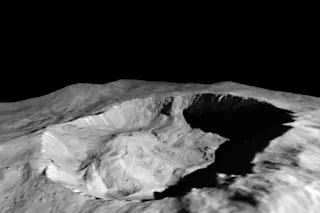NASA’s Dawn mission has uncovered a wealth of information about the largest objects in our asteroid belt: Vesta and Ceres. Since its arrival at the latter in 2015, the spacecraft has revealed an active icy world full of surprises, one more of which has just risen to the fore: Evidence now indicates that Ceres pole has wandered by at least 36° over time, and the path it took to its present location hints at an ancient slushy ocean beneath its crust. In a paper published October 8 in Nature Geoscience about Ceres composition, Planetary Science Institute Senior Scientist Pasquale Tricarico outlines density variations in the dwarf planet’s crust, which can be used to identify features present and past. For example, today the dwarf planet’s topography shows signs of a high-density feature along its equator that lines up with Ahuna Mons, Ceres’ highest peak and former ice volcano.
But Tricarico also ...














